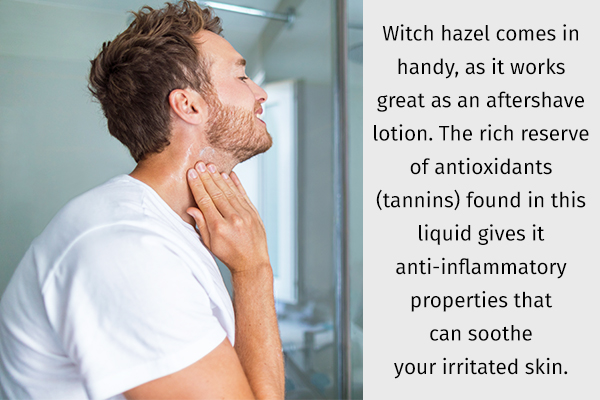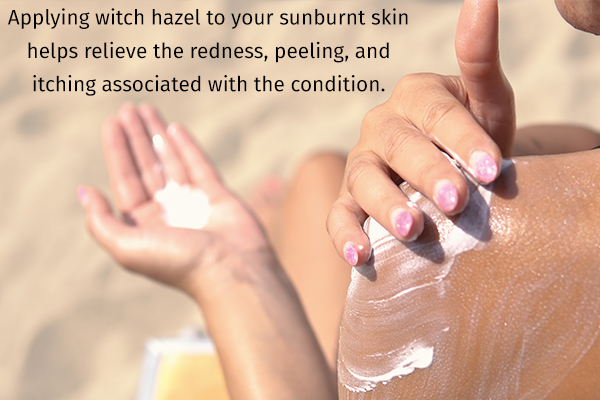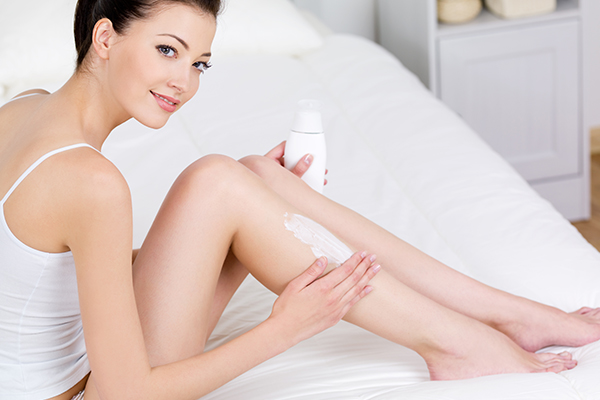In this article:
Witch hazel is a shrub that is indigenous to North America but has gained popularity over the world for its various pharmacological and household uses. (1)

Witch hazel has long been used in traditional medicine, beauty remedies, and domestic cleaning, but this article will mainly focus on its dermatological benefits.
Note: Do a patch test before using any of the following topical remedies to rule out allergies or adverse skin reactions. If you notice any irritation, it’s best not to try the remedy.
6 Beauty Benefits of Witch Hazel
Witch hazel can be a useful topical remedy for the following skin problems:
1. Acne
Witch hazel is an excellent home treatment for acne. Large open pores accumulate oil, dirt, and dead skin cells that serve as fodder for acne-causing bacteria to grow rapidly and cause an infection. Witch hazel helps prevent that.
It works as a natural astringent that shrinks your pores, balances the pH of your skin, and removes the excess sebum to reduce blackheads, whiteheads, and future breakouts.
Plus, it is full of tannins with strong antioxidant and anti-inflammatory properties (2) that help calm the redness and swelling associated with acne lesions. (3)
You can prepare witch hazel pads yourself.
How to use:
- Mix ½ cup of cucumber water, ½ cup of witch hazel, and 15–20 drops of tea tree oil in a bowl.
- Take some clean cotton pads, and place them in a jar.
- Pour the prepared solution into the jar such that all the pads are completely soaked, and close the lid.
- Swipe these pads on your face.
- Use this remedy daily for best results.
2. Razor burns

Shaving with a lot of force, on dry skin, or opposite to the direction of hair growth and using blunt blades causes extreme friction against your skin, often resulting in razor burns. The vigorous rubbing of the blade creates tiny tears in the epidermis, leading to burning, redness, and inflammation.
This is where witch hazel comes in handy, as it works great as an aftershave lotion. The rich reserve of antioxidants (tannins) found in this liquid gives it anti-inflammatory properties that can soothe your irritated skin. (4)
The break in the skin barrier increases the risk of infections, but witch hazel can help on that front as well. It is credited with astringent properties (4) that not only close your pores but also deeply cleanse your skin of sebum and dead cells. Clean, hygienic skin is inhospitable for microbial growth.
How to use:
- Mix 2 tablespoons of witch hazel with 1 tablespoon of cold aloe vera gel in a bowl.
- Apply this mixture to the razor burn.
- Let it dry for 20 minutes before rinsing it off with cool water.
3. Sunburns

Witch hazel may also be used to soothe and heal sunburns, thanks to its rich tannin content. Tannins are antioxidants that help protect, repair, and calm your skin through their anti-inflammatory effects. (5)
Thus, applying witch hazel to your sunburnt skin helps relieve the redness, peeling, and itching associated with the condition. Not just that, it protects the skin from the sun’s ultraviolet A and B (UVA and UVB) rays and helps repair the skin damage caused by them. (6)
How to use:
- Mix 1 part witch hazel and 1 part calamine lotion.
- Apply the mixture to the affected region.
- Leave it to dry on its own.
4. Dry scalp or dandruff
Witch hazel can be a nifty addition to your hair care regimen, especially if you have dry scalp or suffer from dandruff. It helps clear out the dead skin flakes, restore the pH of the scalp, and relieve the itch associated with such conditions. (7)
How to use:
- Put 2 parts witch hazel and 3 parts water in a spray bottle and give it a shake.
- Spritz this solution all over your hair and scalp.
- Massage it into your scalp with your fingers.
- Wait for 5 minutes, and then shampoo and condition your hair as usual.
Note: Consult your doctor before using witch hazel on dry scalp as it is known to remove the natural oils from our skin, which may aggravate the condition.
5. Hyperhidrosis or excessive sweating

Your skin contains sweat glands that release secretions through ducts that open onto the skin. Witch hazel contains tannic acid, which when applied to sweaty areas helps constrict the mouth of these ducts to curb perspiration. (6)
How to use:
- Dip a cotton ball in witch hazel.
- Dab it all over the sweat-prone areas, at least 2–3 times a day.
6. Other conditions
Skin inflammation caused by insect bites, allergies, and rashes usually manifests in the form of itching, redness, swelling, and pain. The strong anti-inflammatory properties of witch hazel can help relieve all these symptoms when used topically.
How to use:
- Mix 3 drops of witch hazel in 1 cup of water.
- Soak a cotton ball in the solution and dab it all over the affected skin.
Possible Side Effects of Witch Hazel
Here are a few adverse skin reactions associated with witch hazel:
- Witch hazel is known to remove sebum from your skin. This effect is good for individuals with oily skin but can be counterproductive for people with already dry skin.
- Witch hazel contains tannins and eugenol, both of which might trigger allergic reactions in persons who are sensitive to them.
- Witch hazel, when used in higher concentrations and on its own, may be too harsh for sensitive skin and may disrupt its natural acid mantle, compromising its barrier function.
Is It Necessary to Moisturize After Using Witch Hazel?

Witch hazel can dry out your skin by removing the natural oils from your skin, on account of its inherent astringent properties. Thus, it’s highly recommended to use a moisturizer after treating your skin with witch hazel.
Final Word
Witch hazel is a popular ingredient in a number of cosmetic products and as a home remedy, and it is used to treat several skin conditions. If you experience any irritation or signs of an allergic reaction when using witch hazel, stop using it and see your dermatologist.
- Was this article helpful?
- YES, THANKS!NOT REALLY


